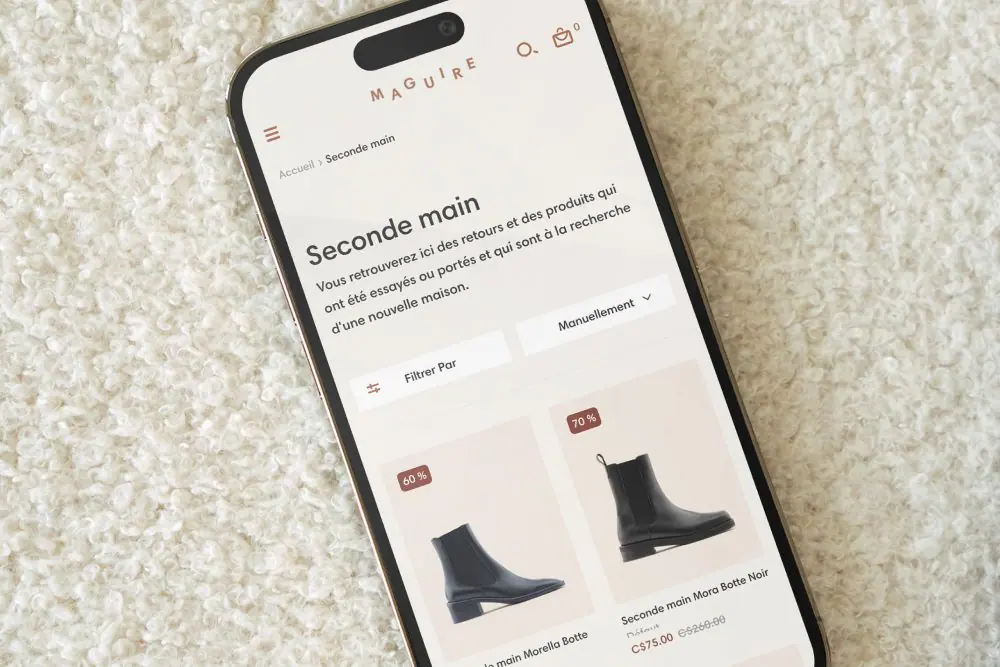31 Jul 2024
Are Canadians interested in buying second-hand products online?

A study made by Novatize and Léger in Canada in 2024 reveals that 57% of consumers are inclined to buy used or second-hand products online. This is an important trend that is already gaining strong support. In fact, 52% of Canadians have already purchased a used product via an eCommerce site.
Where can I buy and sell used products online?
Online transactions for second-hand items can take place via several types of platform. Here are just a few examples:
- Social networks (e.g. Facebook Marketplaces)
- Resale platforms (e.g. Craigslist, Kijiji)
- Auction platform (e.g. eBay)
- Specialized resale applications (e.g. Auto Hebdo)
- Collaborative resale and exchange applications (e.g. Lucky Sweater)
- On brands’ second-hand marketplaces (Re-commerce) (e.g. IKEA Seconde vie)
Discover 10 tools to make your eCommerce consumption more responsible and sustainable.
What is Re-commerce?
Re-commerce refers to the buying and selling of second-hand or reconditioned products. This business model is based on the reuse of goods to extend their life cycle and reduce waste.
Re-commerce includes several practices, such as :
- Resale of used goods: Individuals or companies sell items they no longer use, such as clothes, electronics, furniture, books, etc..;
- Reconditioning : Used products, especially electronics, are repaired, rebuilt and sold as reconditioned;
- Product purchase and trade-in: Companies buy second-hand products, recondition them if necessary, and sell them on;
- Online platforms: Websites and applications that facilitate contact between buyers and sellers of second-hand products.
“By 2030, the Re-commerce sector is expected to be worth $84 billion, almost double that of fast fashion”. (1) With the Re-commerce app or similar, your customers can take back second-hand items when they’re no longer needed, in exchange for cash (bank transfer) or in-store credit with your Shopify store.
Re-commerce is growing rapidly, driven by environmental awareness, the search for cost savings and the rise of digital platforms facilitating the sale and purchase of second-hand products. Find out more about eCommerce trends to watch in 2024.

How can a brand sell second-hand products?
There’s also a trend for leading sustainable brands to offer a platform for reselling used products on their own websites. Retailers such as SAIL, Womance, Patagonia, Parmi Lifewear and Maguire Shoes have set up this type of platform in recent months.
As well as being an opportunity to position yourself as an ethical and sustainable brand, there are real business opportunities for merchants who are going to offer this option to their customers. That’s 41% of the Canadian population who have already bought a product online and intend to do so again, and 16% who have never bought second-hand products online, but would be interested in doing so. (2)
Brands can come up with different strategies for giving their products a second life. For example:
- Hold a liquidation sale that could include both second-hand products, but also slightly damaged products, demonstration products or other;
- Set up a resale platform that gives resellers incentives (e.g., a credit on their next purchase or a gift card);
- Create a campaign to recover used products and refurbish them, donate them to a cause, or offer them at low cost to people in need in exchange for an incentive (e.g., a discount on a future purchase).

Are consumers inclined to buy used products online?
Canadians’ support for buying second-hand products online is quite high, with 57% of them inclined to do so. Their motivations vary: some want to save money or limit the environmental impact of their purchase, while others are looking for unique products.
Generally speaking, younger consumers are more inclined to buy used products online. For 18-34 year-olds, it’s 66%, while for those aged 55 and over, it’s 48%. (3) 58% of consumers aged 35 to 54 have already bought used products online. According to a study by Mordor Intelligence, used products are particularly popular in the games and toys, and children’s clothing industries. Parents are therefore an attractive target for eCommerce companies wishing to sell used products. (4)
If you decide to offer your customers these options, here are a few tips for limiting the environmental impact of your eCommerce delivery process.
Want to continue the discussion and learn more about sustainable eCommerce practices? Contact an expert at Novatize, a certified B Corp firm.
Want to optimize your eCommerce conversion rate?

Sources :
(1) What is Recommerce? (+ How to Sell Resale Goods in 2024), https://www.shopify.com/ca/retail/resale-programs
(3) Ibid
Inspired by what you’ve read?
Our team of experts can help you take your eCommerce to the next level!


